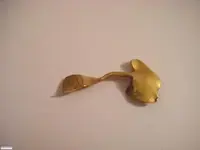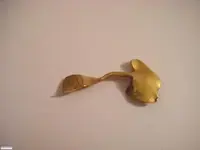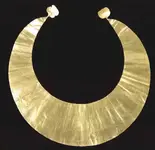ukeden
Full Member
spoke to a flo from the museum today and she told me my fragment is part of a lunula necklace from the bronze age she seamed very excited about the find i have to go and see her next Wednesday were she will give me a report and information ..........:-)
Gold lunula is the term used to describe a distinctive type of early Bronze Age necklace shaped like a crescent moon. Gold Lunula are found most commonly in Ireland, but there are moderate numbers in other parts of Europe as well, particularly Great Britain. Although no lunula has been directly dated, from associations with other artefact's it is thought they were being made sometime in the period between 2200-2000BC (Needham 1996, 124). Less than two hundred gold lunulae are known and it is possible they were all the work of a handful of experts.
The most telling lunulae discovered were from Kerivoa, Brittany. Here three lunulae were discovered in the remains of a box with some sheet gold and a rod of gold. The rod had its terminals hammered flat in the manor of the lunuae. From this it is thought that Lunulae were made by hammering a rod of gold flat so it became sheet-like and fitted the desired shape. Decoration was then applied by impressing designs with a stylus. The stylus used often leaves tell-tale impressions on the surface of the gold and it is thought that all the lunulae from Kerivoa, and another two from Saint-Potan, Brittany and Harlyn Bay, Cornwall were all made with the same tool. This suggests that all five lunulae were the work of one craftsperson and the contents of the Kerivoa box their tools of trade.
Gold lunulae have decorative patterns very much resembling contemporary beaker pottery. They also resemble amber and jet spacer necklaces, which are thought to be slightly later in date. The ideology associated with this type of pattern is unknown. Equally the ideological link between the different materials these necklaces were made of remains a mystery.
UPDATE !!!!
hi forgot to let u no no Ive bean to the musem didn't get a lot more info other than it will go to an inquest to be declared as treasure and then a report would be done and valued that's all i can add for now i shure would like to find the rest
UPDATE 12/09/08
today my lunula was declared treasure i wont be getting it back but it will be going to a local museum i was told the value would be betwean £500 and £1000 split between me and the farmer think i will put the money towards a new detector that has depth love my whites egale though..
2/17/09 valuation
today my letter has come from the British museum they have valued the pice at £500 their was a whole one offed for sale at sotherbys in in December 1990 value £15,000-£20,000 witch was withdrawn as far as I'm aware their is no other lunula ever bean offed for sale in the open market any comments on value welcome to me its priceless and i would rather keep it thanks for reading
Gold lunula is the term used to describe a distinctive type of early Bronze Age necklace shaped like a crescent moon. Gold Lunula are found most commonly in Ireland, but there are moderate numbers in other parts of Europe as well, particularly Great Britain. Although no lunula has been directly dated, from associations with other artefact's it is thought they were being made sometime in the period between 2200-2000BC (Needham 1996, 124). Less than two hundred gold lunulae are known and it is possible they were all the work of a handful of experts.
The most telling lunulae discovered were from Kerivoa, Brittany. Here three lunulae were discovered in the remains of a box with some sheet gold and a rod of gold. The rod had its terminals hammered flat in the manor of the lunuae. From this it is thought that Lunulae were made by hammering a rod of gold flat so it became sheet-like and fitted the desired shape. Decoration was then applied by impressing designs with a stylus. The stylus used often leaves tell-tale impressions on the surface of the gold and it is thought that all the lunulae from Kerivoa, and another two from Saint-Potan, Brittany and Harlyn Bay, Cornwall were all made with the same tool. This suggests that all five lunulae were the work of one craftsperson and the contents of the Kerivoa box their tools of trade.
Gold lunulae have decorative patterns very much resembling contemporary beaker pottery. They also resemble amber and jet spacer necklaces, which are thought to be slightly later in date. The ideology associated with this type of pattern is unknown. Equally the ideological link between the different materials these necklaces were made of remains a mystery.
UPDATE !!!!
hi forgot to let u no no Ive bean to the musem didn't get a lot more info other than it will go to an inquest to be declared as treasure and then a report would be done and valued that's all i can add for now i shure would like to find the rest
UPDATE 12/09/08
today my lunula was declared treasure i wont be getting it back but it will be going to a local museum i was told the value would be betwean £500 and £1000 split between me and the farmer think i will put the money towards a new detector that has depth love my whites egale though..
2/17/09 valuation
today my letter has come from the British museum they have valued the pice at £500 their was a whole one offed for sale at sotherbys in in December 1990 value £15,000-£20,000 witch was withdrawn as far as I'm aware their is no other lunula ever bean offed for sale in the open market any comments on value welcome to me its priceless and i would rather keep it thanks for reading

Attachments
Upvote
1






 Simply incredible! I can't imagine finding something that OLD, let alone digging it out of the ground and holding it in my hand. Congrats on the banner, too.
Simply incredible! I can't imagine finding something that OLD, let alone digging it out of the ground and holding it in my hand. Congrats on the banner, too. Whatever it is, it is a true treasure to have found!
Whatever it is, it is a true treasure to have found!
